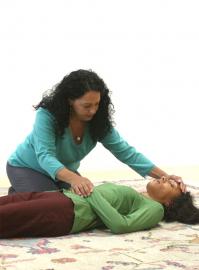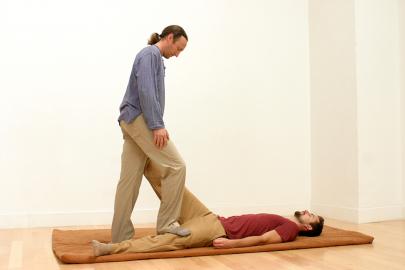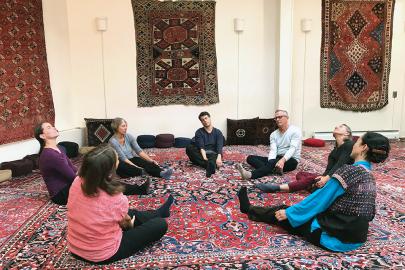
Coming to Balance
I recently did a Breema bodywork session at an open house event. The person I worked with had no idea what to expect, but was enthusiastically invited by a good friend who had received Breema often. Before greeting her I noted that I was preoccupied with thoughts about meeting a deadline at my job, and feeling anxious about that. I was holding my breath, and there was a lot of tension in my face and shoulders. I decided it was a good time to apply Breema’s practical Principles.
My recipient lay down on the carpet and I sat at her feet, taking a moment to come to body-mind connection, until I knew that my body was breathing and had weight. When I felt more connected to myself, I connected to my recipient. As I started to lean into her feet, simply registering the movement of my shifting weight supported my body-mind connection to deepen. As I raised her legs, I remembered Body Comfortable, and adjusted my position as needed. The thoughts and worries went to the background, my mind became quiet, and my feelings calmed down. Remembering Full Participation, the pressure of an upcoming deadline lessened as I fully engaged in leaning, brushing, tapping and holding on the recipient’s body, as if it were the only thing I needed to be doing in the moment.
After the session, I recognized that I now had more energy and availability to finish the project at my job. As we parted, the recipient expressed gratitude for the relaxing and revitalizing effect of the bodywork she received, and I was inwardly grateful for the balancing effect I experienced.
I learned how to benefit from coming to body-mind connection and from practicing those two Principles (Body Comfortable and Full Participation) and the other Principles by studying Breema for many years, and now I use these tools not just in the classroom but in everyday life.
Headquartered in Oakland, California, Breema is practiced and taught around the world. It consists of two forms of bodywork—done with another person or by oneself—with the aim of becoming present. This comprehensive system is based on a profound yet accessible philosophy, epitomized by the Nine Principles of Harmony. Although many massage therapists and other body-based practitioners have found it extremely useful in their work with clients, because the emphasis is on the body as a vehicle for presence, anyone can benefit from bringing aspects of Breema to their own lives.
Connecting to Oneself
In a Breema class, the first step is to connect to oneself and establish body-mind connection, to support becoming and remaining present. So as we learn and practice bodywork sequences with another student, or do the Self-Breema movement exercises that the Instructor demonstrates, our aim is to bring the mind to be with what the body is doing. We practice this over and over, but what we find is that it does not become stale and repetitive at all. In fact, when we have an actual moment of being present—when our essential feelings connect to the body and mind and bring in fresh energy and aliveness—that moment is totally new, and we have a taste of our own existence. We also discover that giving Breema is as nurturing and beneficial as receiving Breema.
Mary Cuneo, who studied dance for many years and has been a Breema Instructor for over 25 years, described her experience of this. “When I received my first Breema session from Jon Schreiber, director of the Breema Center and the Breema Clinic, it seemed like a dance for two. No effort was required of me, yet the movements had a balanced give-and-take of body weight, a naturally rhythmic flow, and an unexpected variety. I didn’t at all feel that someone was doing something to me or for me, but rather with me—an active partner and a receptive one.”
“Once I decided to take a Breema class I was again amazed. One night in class I was practicing a very simple rhythmic leaning motion that was a component of that evening’s Breema sequence. I heard the instructor saying, once again, ‘Do Breema for yourself. Register that your body is breathing and that your body has weight and movement. Participate fully in what you are doing.’ At that moment, I became willing to include myself in my activity, instead of performing it for the benefit and approval of someone else. What a new experience that was. I could have kept leaning all evening— there was such joy in being so connected to my own body. That simple bit of bodywork gave me one of my life’s most deeply fulfilling moments, and led to many more.”
Guidelines for Harmonious Relationships
Local resident Gail Coonen, who is a Breema Practitioner and Self-Breema Instructor, expressed how she finds Breema of benefit.
“Along with doing bodywork with another person, there is Self-Breema, another form of Breema I teach and do by myself, for myself,” she said. “Whenever I am restless or in conflict, or become tense or tired, doing one or two Self-Breema exercises restores me to balance, physically and psychologically. Then I am refreshed and grounded, and can go forward with more clarity and direction.”
Gail continued, “Coupled with the bodywork are the Nine Principles of Harmony that are taught in class as guidelines to apply while giving and receiving as well as to the events of one’s life. I found this so unique when I started studying Breema.”
“Presently, when I practice Breema and Self-Breema, Mutual Support and Single Moment/Single Activity are Principles that often come alive for me. They deepen my participation in and appreciation for the time I am with someone else, or with myself. As I integrate the Principles into my life, I apply their wisdom to the issues that arrive daily— while interacting with others, taking care of health concerns, and meeting the demands on my time, energy, and money.”
Arlie Mischeaux, a Staff Instructor at the Breema Center and a practitioner at the Breema Clinic, has seen how Breema’s philosophy and Principles create an atmosphere that benefits both practitioner and client.
“At the Clinic we don’t see the client as a body with a set of symptoms, which would diminish them. Our approach sees that they have a body, but they are not just the body on the level of matter and energy. They are also the consciousness that created and sustains the body, which is connected to the source of all that exists. Acknowledging this essential aspect—who they really are instead of who they think they are—makes receiving the bodywork a profoundly freeing and transformative experience.”
“In each session, I start with body-mind connection, then work with the Principles. No Judgment is an important key. I wish to have no judgment of the recipient, but I can only do that inasmuch as I have acceptance of myself. With No Judgment, I can move toward accepting myself as I am, at any moment. As I accept myself, wordlessly, the client gives themselves permission to accept themselves as well, and they can let go of anything they don’t need. This is the beginning of real health.”
Essential Support for Daily Life
To support our wish to be more present, we cannot function from one center at a time, as we usually do. If only the mind is in charge, our life is limited by habitual thoughts. If only the feelings are in charge, our life is limited by reaction to the events of life. If only the body is in charge, our life is limited by our physical need for comfort and pleasure.
Breema gives us a way to have what we do be a three-centered activity. When the mind, body, and feelings work together in harmony, we may come to a taste of being present, where the mind is clear, the feelings are calm, and the body is vital. In that taste, we accept things as they are, and know we exist as part of a greater whole. We can participate in our lives with more balance, harmony, and well wishing for ourselves and others, bringing more meaning to whatever we do.
*Breema: Presence and Harmony was written by Elaine Pendergrast and originally published in the Wholistic Heartbeat. Elaine is a Staff Instructor at the Breema Center in Oakland, California.

